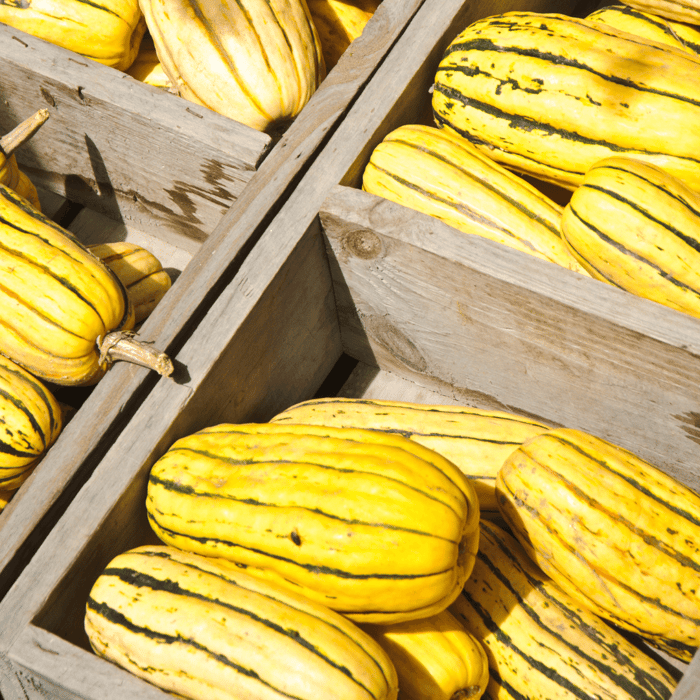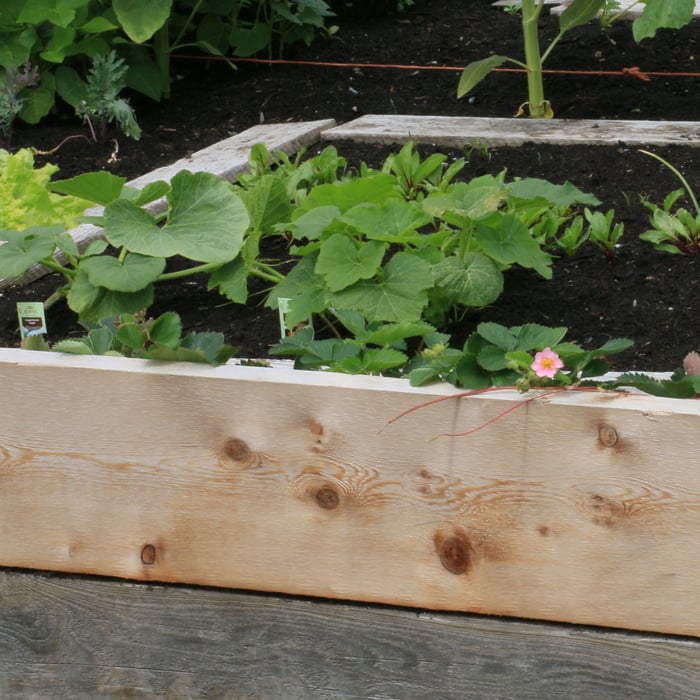Hi there, fellow gardeners! I'm a passionate gardener, and I'm excited to share my experience growing spaghetti squash with you. This delicious and versatile vegetable is easy to grow and a healthy addition to your diet. So, let's dive into the beautiful world of how to grow spaghetti squash.
This comprehensive guide will cover the following topics:
- Introduction to Spaghetti Squash
- Plant Characteristics
- Choosing the Right Seeds
- Preparing the Soil
- Planting and Germination
- Caring for Your Spaghetti Squash Plants
- Pests and Diseases
- Harvesting and Storing Spaghetti Squash
1. Introduction to Spaghetti Squash
Spaghetti squash, or Cucurbita pepo, is a type of winter squash that originated in Central America. It is called "spaghetti" squash due to its unique ability to form spaghetti-like strands when cooked, making it a popular low-carb alternative to pasta. Unlike most other winter squashes, spaghetti squash is considered one of the summer squashes, as it has a shorter growing season and a more tender texture.
Spaghetti Winter Squash Seeds
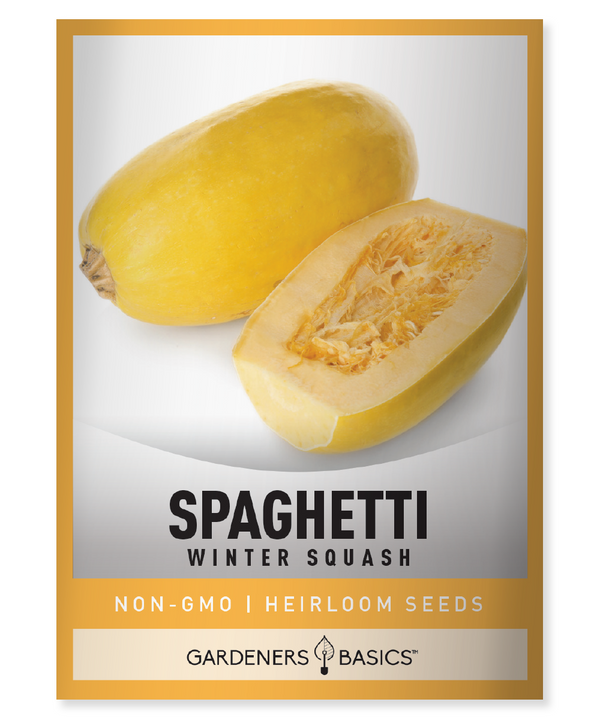
$2.49
Spaghetti Squash Seeds - Heirloom, Non-GMO, Non-Hybrid, Open-Pollinated Grow your own delicious and nutritious Spaghetti Winter Squash with our premium heirloom seeds! Perfect for home gardeners and enthusiasts, these non-GMO, non-hybrid, open-pollinated seeds ensure high-quality, reliable harvests. Spaghetti Squash is… read more
2. Plant Characteristics
Here's a quick overview of spaghetti squash plant characteristics:
- Native: Central America
- Family: Cucurbitaceae
- History of the Seed: Domesticated over 3,000 years ago in Central America
- Days till maturity: 90-100 days
- Planting depth: 1 inch
- Plant spacing: 4-5 feet apart
- Days to germination: 7-14 days
- Start indoors or direct sown: Both options work well
- Full sun or partial shade: Full sun
- When to harvest: When the rind is hard, and the skin turns from green to golden or tan
- Plant Height: 1-2 feet
- Plant Width: 3-4 feet
- Annual or Perennial: Annual
3. Choosing the Right Seeds
Start your squash garden by selecting high-quality spaghetti squash seeds for planting. You can choose from various heirlooms, vegetables, and garden seeds at gardenersbasics.com. Purchasing seeds from a reputable source is essential to ensure healthy, productive plants.
4. Preparing the Soil
Spaghetti squash requires well-draining soil rich in organic matter. Start by clearing the planting area of any weeds, rocks, or debris to prepare the ground. Then, work in aged compost, well-rotted manure, or other organic amendments to a depth of 8-12 inches. This will help improve the soil structure and provide essential nutrients for healthy plant growth.
Testing the soil pH is also essential, as spaghetti squash prefers a slightly acidic to neutral pH range of 6.0 to 6.8. If your soil is too acidic or alkaline, you can amend it with lime or sulfur to reach the desired pH level. Remember to choose a location with full sun, as spaghetti squash thrives in warm, sunny conditions.
5. Planting and Germination
To start sowing spaghetti squash seeds indoors, sow seeds 3-4 weeks before the last frost date. Fill individual pots or seed trays with a high-quality seed starting mix. Plant the seeds 1 inch deep, placing two seeds per pot. After germination, thin out the weaker seedling. Maintain a temperature of around 70°F for optimal germination, and put the seed trays in a warm, well-lit location, such as a windowsill or under grow lights.
Create small hills or mounds in your prepared garden bed for direct sowing, 4-5 feet apart. Plant 4-6 seeds per hill, 1 inch deep, and thin to the two most robust seedlings once they have a few sets of true leaves. This will allow room for the sprawling squash vines and help prevent overcrowding.
6. Caring for Your Spaghetti Squash Plants
Supporting the Vines
As your spaghetti squash plants grow, their vines can become quite heavy, especially when laden with fruit. You can use a trellis or other support structure to help support the vines and keep the fruit off the ground. This helps prevent rot and damage and makes it easier to harvest squash and manage pests and diseases.
Companion Planting
Spaghetti squash can benefit from companion planting with certain other plants. For example, planting nasturtiums or marigolds nearby can help deter pests like aphids and squash bugs. Additionally, planting herbs like dill, basil, or parsley can attract beneficial insects that help control pests and promote pollination.
Crop Rotation
To help prevent the soil's buildup of pests and diseases, practice crop rotation by not planting spaghetti squash or other cucurbits (such as cucumbers, melons, or different squash varieties) the same spot for at least three years.
Watering
Water spaghetti squash plants regularly, providing about 1 inch of water per week. Ensure the soil stays consistently moist but not waterlogged. Watering in the morning is recommended to prevent the growth of mold and mildew.
Fertilizing
Feed your plants a balanced, all-purpose fertilizer every 4-6 weeks throughout the growing season. This will help support steady growth and promote fruit development.
Mulching
Spread a layer of organic mulch, such as straw or wood chips, around the base of the plants to help conserve moisture, suppress weeds, and maintain a consistent soil temperature.
Pruning
Prune your squash plants by removing any dead or diseased leaves and vines. This will encourage better air circulation and help prevent the spread of diseases.
Pollination
Spaghetti squash plants produce both male and female flowers. To ensure successful pollination, you can hand-pollinate the flowers by transferring pollen from male flowers to female flowers using a small paintbrush or cotton swab. Alternatively, you can attract pollinators like bees and butterflies to your garden by planting flowers nearby.
Heirloom Squash Seeds | 5 Variety Pack
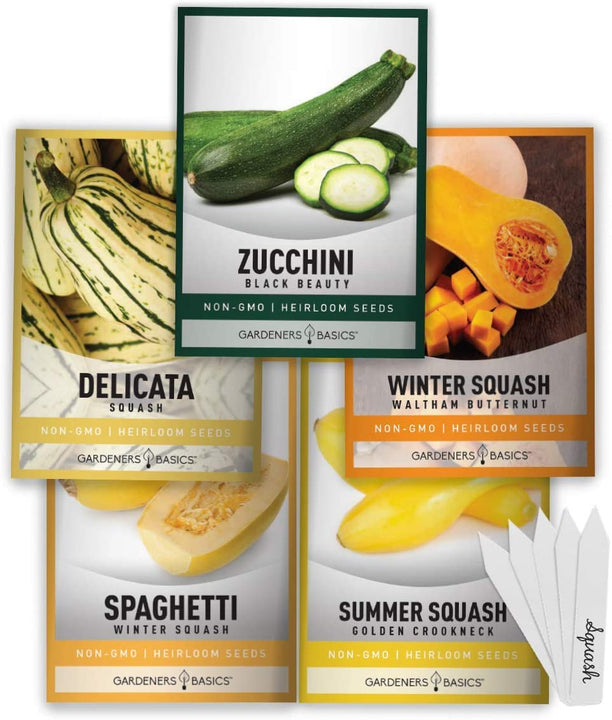
$9.95
5 Squash Seeds Variety Pack: Heirloom, Non-GMO, Open-Pollinated Squash Seeds for Vegetable Gardening Our 5 Squash Seeds Variety Pack is the ultimate collection for garden enthusiasts and squash lovers! Whether you're' a seasoned gardener or just starting out, this heirloom… read more
7. Pests and Diseases
Spaghetti squash plants are susceptible to common pests like squash bugs, cucumber beetles, and aphids. Inspect your plants regularly for signs of infestation and treat them promptly with organic insecticides or by introducing beneficial insects like ladybugs and lacewings.
Fungal diseases, such as powdery mildew and downy mildew, can also affect your squash plants. To prevent the spread of diseases, maintain good air circulation, avoid overhead watering, and promptly remove any affected plant material.
8. Harvesting and Storing Spaghetti Squash
To harvest spaghetti squash, wait until the rind has hardened and the skin has turned from green to golden or tan. You can test the rind's hardness by trying to pierce it with your fingernail – if it resists, it's ready for harvest. Use a sharp knife or pruning shears to cut the squash from the vine, leaving about 1-2 inches of stem attached.
Allow the squash to cure in a cool, dry location with good air circulation for 10-14 days before storing. Properly cured and stored spaghetti squash can last up to 3 months in a cool, dry place like a basement, garage, or root cellar. Ideal storage temperatures are between 50-60°F, with a relative humidity of 50-70%. Store the squash in a single layer, not touching each other, to help prevent rot and spoilage.
During storage, check your squash periodically and remove any that show signs of rot or deterioration.
In Conclusion
Growing spaghetti squash is a rewarding experience that can provide a delicious and nutritious addition to your diet. Following this comprehensive step-by-step guide, you can enjoy a bountiful harvest of spaghetti squash from your garden. Remember to prepare the soil, plant the seeds correctly, care for your plants, and protect them from pests and diseases. Happy gardening!
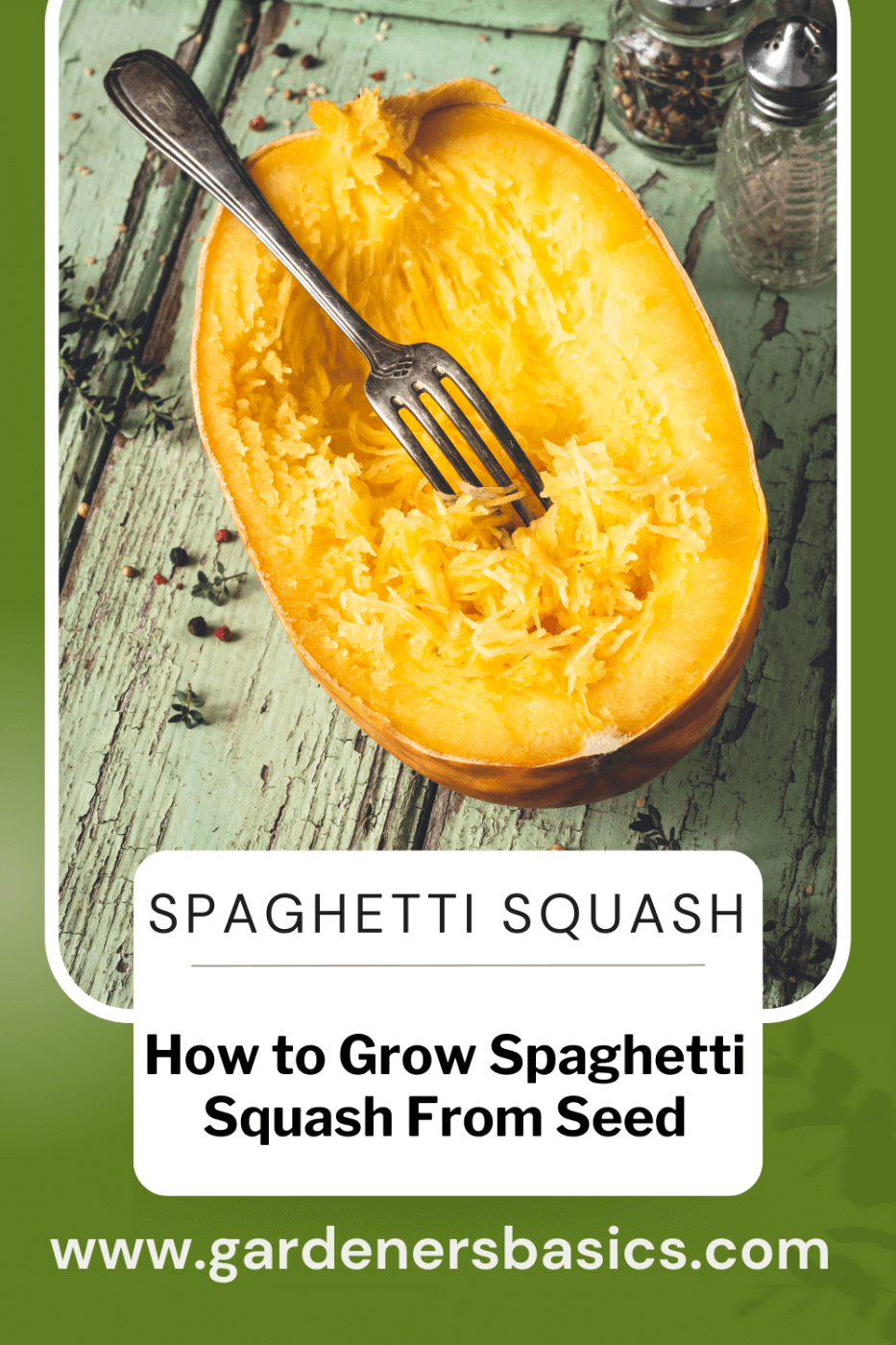
 Frequently Asked Questions (FAQ) - How to Grow Spaghetti Squash
Frequently Asked Questions (FAQ) - How to Grow Spaghetti Squash
Q1: How long does it take for spaghetti squash to mature?
A1: Spaghetti squash typically takes 90-100 days to mature from planting to harvest. The exact time may vary depending on the variety, growing conditions, and local climate.
Q2: Can I grow spaghetti squash in a container?
A2: You can grow spaghetti squash in a large container (at least 5 gallons) with proper drainage holes. However, you will need to provide additional support for the vines, such as a trellis or cage, to help manage the plant's growth and prevent the fruit from touching the ground.
Q3: How do I know when my spaghetti squash is ripe and ready for harvest?
A3: Your spaghetti squash is ready for harvest when the rind has hardened and the skin has turned from green to golden or tan. You can test the rind's hardness by attempting to pierce it with your fingernail – if it resists, it's ready to harvest.
Q4: Can I eat spaghetti squash raw?
A4: While spaghetti squash can technically be eaten raw, it is usually cooked to soften the flesh and create the spaghetti-like strands for which it is known. Before using it in your favorite recipes, you can roast, steam, or microwave the squash to achieve the desired texture.
Q5: How do I store spaghetti squash after harvesting?
A5: After harvesting, allow the squash to cure in a cool, dry location with good air circulation for 10-14 days. This helps harden the rind and improve storage longevity. Store cured spaghetti squash in a single layer, not touching each other, in a cool, dry place like a basement, garage, or root cellar. Ideal storage temperatures are between 50-60°F, with a relative humidity of 50-70%. Properly cured and stored spaghetti squash can last up to 3 months.
Q6: How often should I water my spaghetti squash plants?
A6: Water spaghetti squash plants regularly, providing about 1 inch of water per week. Ensure the soil stays consistently moist but not waterlogged. Watering in the morning is recommended to prevent the growth of mold and mildew.
Non-GMO Squash Seeds | 8 Variety Pack
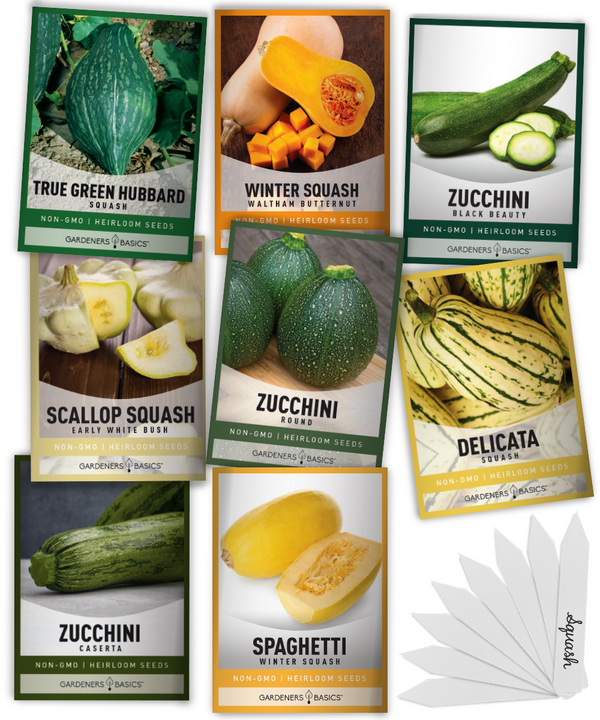
$15.95
Ultimate 8 Squash Seeds Variety Pack for Home Gardeners – Heirloom & Non-GMO Seeds Introducing our 8 Squash Seeds Variety Pack—the ultimate selection for gardeners who love cultivating a diverse range of delicious, homegrown squash! This carefully curated variety pack… read more
Q7: Can I save spaghetti squash seeds for planting next year?
A7: You can save spaghetti squash seeds for planting the following year. However, it's essential to note that if you grow different varieties of squash or other cucurbits in your garden, there's a chance of cross-pollination, which may affect the characteristics of the resulting plants. To save seeds, scoop them out of a ripe squash, clean them thoroughly, and dry them completely before storing them in a cool, dry place until the next planting season.
Q8: What common pests and diseases affect spaghetti squash plants?
A8: Spaghetti squash plants are susceptible to common pests like squash bugs, cucumber beetles, and aphids. They can also be affected by fungal diseases such as powdery mildew and downy mildew. Regularly inspecting your plants, prompt treatment, and good gardening practices can help manage these issues.
Q9: Do spaghetti squash plants need full sun?
A9: Spaghetti squash plants require full sun to grow and produce fruit. They thrive in warm, sunny conditions and should receive at least 6-8 hours of direct sunlight daily.
Q10: Can I grow spaghetti squash vertically?
A10: You can grow spaghetti squash vertically using a trellis or other support structure. This helps support the vines and keep the fruit off the ground, and makes it easier to harvest the squash and manage pests and diseases. Remember to provide adequate space for the vines to grow and avoid overcrowding your plants.





